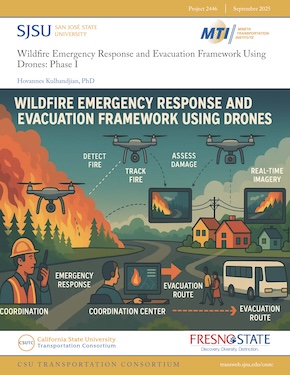- 408-924-7560
- mineta-institute@sjsu.edu
- Donate
Wildfire Emergency Response and Evacuation Framework Using Drones: Phase I
Wildfires are escalating in frequency and severity due to climate change, posing increasing threats to human life, infrastructure,and ecosystems. Traditional wildfire management systems struggle to respond effectively to rapidly evolving fire conditions. This research presents a novel, AI-powered Wildfire Emergency Response and Evacuation Framework that integrates autonomous unmanned aerial vehicles (UAVs, AKA “drones”), multi-sensor data fusion, and machine learning (ML) for real-time fire detection, evacuation planning, and search and rescue (SAR) operations. Central to the system is the Dynamic Wildfire Response Algorithm (DWRA), a hybrid decision-making framework combining AI-driven techniques including reinforcement learning (RL), genetic algorithms (GA), and deep learning that enable adaptive and data-driven response coordination. The system uses infrared (IR) and visible-spectrum cameras, LiDAR, weather sensors, and a data processing technique called edge computing (e.g., NVIDIA Jetson AGX Orin) to provide on-board intelligence and low-latency decision-making without cloud reliance. The combination of these sensors and innovations enables the new framework to respond to wildfires with accuracy and efficiency unseen in traditional management systems. Extensive prototype testing of the framework demonstrated a fivefold improvement in fire detection speed, 28% faster evacuation times, and a 35% increase in SAR efficiency over traditional methods. The results confirm the viability of this framework as a scalable, autonomous solution to wildfire emergencies, with the potential to significantly reduce response time, improve situational awareness, and save lives in high-risk fire zones. Future work will focus on expanding drone swarm capabilities, integrating real-time emergency service communication, and enhancing endurance through solar-powered charging infrastructure. By combining innovative technology with real-time adaptability, this research lays the foundation for a next-generation wildfire response system that is faster, smarter, and better equipped to meet the growing challenges of a world grappling with the effects of climate change.
Hovannes Kulhandjian
Dr. Hovannes Kulhandjian is a tenured full Professor in the Department of Electrical and Computer Engineering at California State University, Fresno (Fresno State). He joined Fresno State in Fall 2015 as a tenure-track faculty member. Before that, he was an Associate Research Engineer in the Department of Electrical and Computer Engineering at Northeastern University. He received his B.S. degree in Electronics Engineering with high honors from the American University in Cairo (AUC) in 2008, and his M.S. and Ph.D. degrees in Electrical Engineering from the State University of New York at Buffalo in 2010 and 2014, respectively. His current research interests are in applied machine learning, autonomous vehicle navigation, wireless communications, and networking, with applications to underwater and visible lightcommunications and networking geared towards Intelligent Transportation Systems (ITS).
Dr. Kulhandjian has received six research grants from the Fresno State Transportation Institute (FSTI); the Claude C. Laval III Award for Commercialization of Research, Innovation, and Creativity 2021; as well as the Claude C. Laval Award for Innovative Technology and Research2020 at Fresno State. In April 2021, as a PI he received a grant from the Department of Defense (DOD) Research and Education Program for Historically Black Colleges and Universities and Minority-Serving Institutions (HBCU/MI) Equipment/Instrumentation, to establish a “Secure Communications and Embedded Systems Laboratory at California State University, Fresno".
Dr. Kulhandjian is an active member of the Association for Computing Machinery (ACM) and the Institute of Electrical and Electronics Engineers (IEEE). He is a Senior Member of IEEE. He is serving as a Guest Editor for Special Issue "Advances in Intelligent Transportation Systems (ITS)". He has served as a Guest Editor for IEEE Access Special Section Journal, Session Co-Chair for IEEE UComms’20 Conference, Session Chair for ACM WUWNet’19 Conference, Publicity Co-Chair for IEEE BlackSeaCom Conference. He also serves as a member of the Technical Program Committee (TPC) for ACM and IEEE Conferences such as GLOBECOM 2022, WTS 2022, WD 2021, WD 2018, ICC 2018, WUWNet 2020, and WiMob2019. He is a recipient of the Outstanding Reviewer Award from ELSEVIER Ad Hoc Networks and ELSEVIER Computer Networks.
-
Contact Us
San José State University One Washington Square, San Jose, CA 95192 Phone: 408-924-7560 Email: mineta-institute@sjsu.edu






